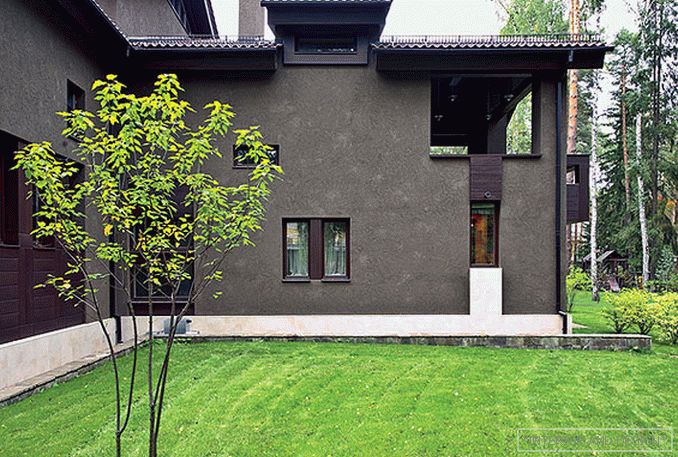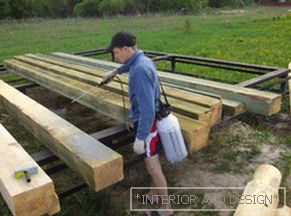 Wood for many centuries is the most sought-after material in construction and finishing works. Boards, bars, logs and other elements can be found in almost every home, in the country and in various buildings. But the tree has one unpleasant feature - it is prone to decay and other biological hazards. And what should be done to protect wooden structures from this scourge? This will be discussed in this article.
Wood for many centuries is the most sought-after material in construction and finishing works. Boards, bars, logs and other elements can be found in almost every home, in the country and in various buildings. But the tree has one unpleasant feature - it is prone to decay and other biological hazards. And what should be done to protect wooden structures from this scourge? This will be discussed in this article.
Content
- 1 Why the tree begins to rot
- 2 Use antiseptics
- 3 Recommendations for selection
- 4 Folk Remedies
- 5 In conclusion
Why the tree begins to rot
Mold or microscopic fungi are often found on wood. It is this enemy, not counting the fire, is the most dangerous for wood products. Rotting can destroy a strong house or any other structure in a matter of days or weeks.
Often wood becomes infected with mold during storage or transportation. But in order for rot to spread rapidly, certain conditions must be met. Namely:
-
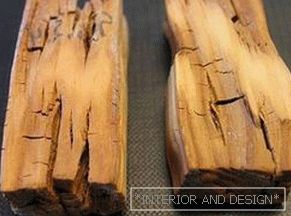 High humidity. This applies both to moisture in the air (the optimal values for mold growth range from 80% to 90%) and to water in the tree itself (more than 15-20%);
High humidity. This applies both to moisture in the air (the optimal values for mold growth range from 80% to 90%) and to water in the tree itself (more than 15-20%); - Air stasis If there is no fresh oxygen (drafts), then the fungi on the tree grow more actively;
- Large and frequent temperature drops, as well as freezing of the material. All this weakens the structure of the tree, and facilitates the growth of mold;
- Contact with soil. From the soil mold fungi receive nutrients.
To prevent the wood from rotting actively, some preventive actions. Here are the main ones:
- if you are going to build a log house, then for this you need to choose dry. It is very important that the drying process of the tree takes place in accordance with the rules and lasts at least one year;
- construction of a house or other structure must be conducted using the foundation. In this case, the wood will not come into contact with the ground, which means that the risk of mold will decrease;
- It is very important to protect the ends of the timber and logs, these places are most vulnerable to the penetration of mold fungi. Most often, the ends obbivayut boards. In addition, it is necessary to periodically inspect (preferably in the spring) in order to identify problem areas in advance and take action.
And, of course, we must not forget about the various impregnations, special solutions and paintwork. This will be discussed in more detail in the following chapters.
We use antiseptics
 In order to cope with the rotting of the tree, it is necessary, besides preventive measures, to use various chemicals. Modern industry produces a large range of similar substances, but the main ones are used for:
In order to cope with the rotting of the tree, it is necessary, besides preventive measures, to use various chemicals. Modern industry produces a large range of similar substances, but the main ones are used for:
- conservation;
- anitseptirovaniya.
The first option is made only in the factory. In special containers, the wood is kept in special solutions. As a result of this "soaking" chemicals get deep into the tree and reliably protect it from the penetration of mold fungi.
Not all wood entering the construction market is subject to the preservation process; therefore, antiseptic products are so popular. These substances can be applied independently and as well as preservatives, they perfectly prevent rotting.
On sale you can find the following types of antiseptics:
- Water soluble. Such tools are very common. Due to the presence of water in the composition, they dry quickly and have almost no odor. Water-soluble antiseptics are great for protecting walls, ceilings, floors and other structures. The only contraindication is that this antiseptic cannot be used when processing wood, which is often in contact with water;
- Water repellent. To protect wooden structures in the bathroom, bathroom or bath, it is better to use just such means. They penetrate deep into the wood and are not afraid of moisture. But such an antiseptic has a strong and strong odor;
- Based on volatile matter. Such means cover the surface with a thick film, which serves as protection against mold penetration;
- Oil based. Such substances are suitable only for dry wood. In addition, oil antiseptics are not recommended for use in residential premises;
- Combined. This is a modern material that can be used for almost any type of wood and in any room. In addition to reliable protection against the penetration of mold fungi, such antiseptics also have a fire prevention effect.
If we talk about specific brands of antiseptics, they are quite a lot. The market is widely represented both domestic and imported materials. The choice is always up to the buyer. Before going to the store, you should visit the Internet forum on construction topics, here you can view reviews of a particular antiseptic. Having received such information, it will be easier for you to make the right choice.
Recommendations for selection
Having come to the store with antiseptics, you will see a large assortment of similar products. It is important here make the right choice, and it can be based on the following recommendations from experts:
-
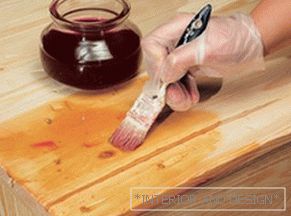 if you need to treat structures that are in the open air or a subfloor, then it is better to take hardly removable antiseptics. Such tools may smell unpleasant, but they are more reliable and durable (up to 30-35 years);
if you need to treat structures that are in the open air or a subfloor, then it is better to take hardly removable antiseptics. Such tools may smell unpleasant, but they are more reliable and durable (up to 30-35 years); - for drawing on logs, floors, fences and other elements whose deformation is undesirable, the manufacturer produces special impregnations and varnishes. Such remedies, in addition to protection from mold, create a layer that prevents dry cracking and reduces shrinkage;
- Do not forget that manufacturers offer antiseptics that additionally protect the wood from fire and other harmful effects. Applying such substances can significantly save.
And do not forget about the periodic update of the protective layer. Any coating or impregnation does not last forever, so when cracks, chips or changes in the color of the wood appear, it is necessary to process all the elements again.
Folk Remedies
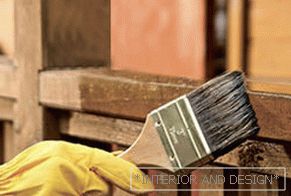 If you are not fans of "chemistry" or do not want to spend extra money, you can use some popular methods to protect wooden elements. For a long history of using such material, a great experience has been accumulated.
If you are not fans of "chemistry" or do not want to spend extra money, you can use some popular methods to protect wooden elements. For a long history of using such material, a great experience has been accumulated.
For example, you can use a mixture of water and superphosphate to fight mold. After mixing the solution, it is applied to the desired surface. Better lay two or three layersso protection will be more reliable.
In addition, you can use another mixture. In 75 parts of ordinary clay 5 parts of table salt is poured and diluted with 20 parts of water. This mixture, as in the previous case, is applied to the surface of the wood. After drying, a crust is formed, which prevents the penetration of mold fungi into the wood.
In addition, there are other methods protect boards and other wood materials from rotting. We list only some of them:
- silicate glue can be used. Dilute it with water and treat problem areas with the solution obtained;
- Soda and vinegar are widely used in folk methods. These substances will help in the fight against mold. Apply baking soda to the desired area, and then, using a spray bottle, spray with vinegar. As a result of a violent reaction, mold fungi will die;
- You can dilute one hundred grams of copper sulfate in 10 liters of water. Wooden elements are treated with this solution. Moreover, this method can help in the fight against mold, which appeared not only on wood, but also on any other surfaces;
- Prepare the following solution: a kilogram of salt and 50 grams of boric acid is taken in 5 liters of boiling water. This tool needs to process damaged surfaces several times, at intervals of 2-3 hours.
Also to protect the exterior wooden elements applied resin. This material is coated with all constructions that are constantly moistened or come into contact with the ground.
Finally
As you can see, there are quite a few ways to combat mold. You can use industrially produced substances or use methods proven by people. If you apply the first option, it is important to carefully read the purchased product. Read the instructions for use and the label itself. It is important that the product is not expired and does not contain a large amount of hazardous substances. But it is best to carefully choose the wooden materials themselves and properly operate them. Then no mold fungi you are not afraid.



